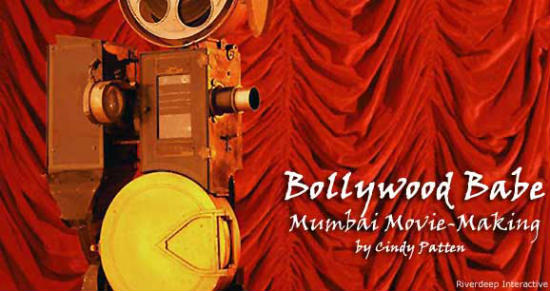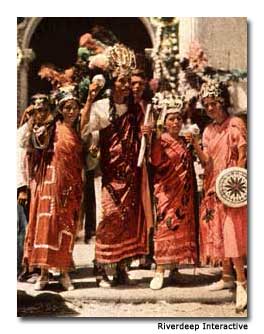

My Bollywood adventure began in the frenetic tourist district of Colaba, in Mumbai, India. Honestly, I had entertained a tiny fantasy of experiencing the Indian movie industry first-hand — but it was far from my mind as I teetered on a narrow (and I do mean narrow: my toes hung off one side and my heels the other) cement median in the middle of four lanes of exhaust-spewing traffic.
I gauged my odds of crossing in one piece as similar to that of the scores of limping dogs that I had seen since arriving in India.“Has anyone approached you about being an extra in a Bollywood movie?”
I threw a quick look over my shoulder to see a clean-cut man in his 30s smiling openly at me. My priorities lay elsewhere: “Help me cross the street!”
I shadowed him through the choked traffic, knowing I had a better chance of traversing unscathed if I used a local as a human shield. (This also works with local elementary school students, I am not ashamed to admit.)
He then presented me with a business card: “Planet Star” Casting Company was looking for 18 “Western European–looking” tourists to work as extras. The terms: to meet at the popular Leopold’s Café the following morning at 7 a.m., from whence we would be taken by luxury coach to the film set.
We would put in a long day of shooting, starting with costumes and makeup, until 6 p.m. or so. Lunch and payment of 500 Indian Rupees (about US$ 10) was included. Was I interested? Absolutely!
Arriving early the next morning, I passed the time in a 24-hour Internet café chatting with family and friends about my exciting day ahead. Everyone was online and our conversations flowed in real time.
“What is the movie called?” my husband inquired. “Doom 2!” I exalted across cyberspace.
Fear cloaked as disapproval churned in his response. “Isn’t that based on an ultra-violent video game?” The actual title was Dhoom 2, as I would learn later, sequel to the hugely successful action flick Dhoom, starring a handful of India’s hottest, hippest actors.
Friends in New Delhi proffered advice. “They will think you are loose because of how you look and because you are Western. But you will be fine because of how you handle yourself.”
At Leopold’s, pockets of already-sweating foreigners sipped instant coffee and downed yellow omelets and cold toast in the silence of steamy dawn. We pooled our information and stoked our imaginations.
“They said we will have beautiful costumes and professional hair and makeup!”
“I wonder if we will have to do stunts?”
“Maybe it will be a battle scene like in Lord of the Rings! Will we have to ride horses?”
“We are going to be movie stars …”
As with every Western expectation of India, the day’s events happily unfolded “something like that.” Our “luxury” coach was filthy and snarled with dents, broken seats and no air-conditioning. But we were heady and ecstatic, up for glorious adventure. This vehicular throwback to the British Raj–era India became our limousine, the driver our personal chauffeur, the roadside pedestrians our fans.
At Studio 5 we were hustled into a long, mirrored room for wardrobe, where we unashamedly rubber-necked for racks of beautiful costumes.
A burly Indian strode in, threw open an enormous metal trunk and began tossing out items of clothing … very small items.
Tank tops, scarves — no, wait, that’s a mini-skirt — and fur-and-feather lined pieces!
The women’s costume pieces were teeny, tiny, tight and revealing. I was presented with a miniscule tube of stretchy fabric.
“You want me to wear this?” Dismissed with a flick of the hand toward the changing room, I didn’t know if my mystery scrap was a top, a skirt or a micro-dress. Remembering my friend’s prophetic words about loose foreigners, I pulled the tube snugly over one trousered thigh, grinning and gesturing comically at the fit.
After two more futile attempts to dress me, I had made my point and was exasperatedly waved on, having earned the right to make my film debut wearing loose-fitting Indian-styled clothes.
“Go! Go-go-go! This way!”
Eighty uniformed primary school children surged toward us, shrieking. Panicked museum staff flapped their arms, attempting to stop the deafening pandemonium. The cavernous exhibit room was smoke clogged, and the giant, thick-boned T-Rex skeleton shook viciously with the force of hundreds of feet pounding the cold floor.
My friend tumbled to her knees in the human tidal wave. As I reached back and grasped her arm to pull her up, in front of us a tiny Chinese girl tripped over her black patent shoes and flopped onto her face. She squinched up her bright eyes and opened her rosebud mouth to wail; I scooped her up and fought through to the safety of the wall of Aztec artifacts.
“Stop! Stop!”
Slowly we all ground to a halt, panting in the humidity. The sense of urgency dissipated with the thinning canned-fog effects and feeble air conditioning. The ivory papier- mâché T-Rex grinned down on us, toothily amused, now only quivering slightly as if in anticipation of the next take.
“Children, there will be no smiling! Any smiling children will be ERASED by the computer!”
In a last-ditch attempt to manipulate the hordes of tiny actors and actresses into taking their jobs more seriously, the frustrated director resorted to techno-terrorist threats projected through a megaphone.

We were into Hour 3 of sprinting, dodging and stomping to escape the gnashing mandibles of “giant spiders” (apparently the size of Jack Russell terriers and much fiercer), to be digitally inserted post-production. A cell phone tinkled distantly, fainter than my pulse slamming in my ears. I sank to the floor, intent on resting my screaming leg muscles before the next grueling take.
“Shut UP! “SHUT UP! Get OFF MY SET! I’m serious — are you serious?”
All sound in the room zippered into imperfect silence. The Big Actor had spoken — screamed, actually — at the man with the cell phone. Tantrums — complete with stomping feet and pin-wheeling arms — continued hourly, much to the amusement of us Westerners, who were used to such antics being confined to the schoolyard.
After each outburst Hair Repair and Makeup workers scurried to repair the damage. Hair Repair held up a melon-sized mirror while The Big Actor scrutinized each combed black lock for perfection, scowling ferociously at his flawlessly handsome, chiseled features. It was reminiscent to a budgie cooing at its own reflection.
It was a long day, 10 hours total. By 6:30 p.m. we were exhausted and not a little fearful that shooting would continue infinitely. But as promised, we were fed a delicious lunch, given hot sweet chai during our frequent breaks, and finally returned to Colaba — paid in full — late that evening.
Much later, at home, I found the movie at my neighborhood video store. Excitedly, I scanned through every scene for a glimpse of myself.
I was surprised at how much was added post-production; even Snow White and the Seven Dwarfs were added in. Then, during a giant-spider action sequence, there I was!
I was relieved that it was a full-body shot from a distance, and not a close-up of my dirty feet. Despite scrutinizing every additional scene, that was it … I was on for all of 1.5 seconds. Ten hours of hard work for just over one second!
I thought back to the director’s commands that day: “ And you will run … and there is precious treasure … and you will run this way … and that way … and … ACTION!”
The director’s orders were unwitting poetry describing India herself: the force of her energy as continuous movement and staccato sound; the frenetic crush and vivacity of her people; and their trueness of purpose and commitment to life. That day, we were pushed and pulled until, finally, filming was stopped and all was quiet.
If You Go
Mumbai Tourism
India Tourism
- Fiddle, Flutes & Pubs: A Musical Journey Through Northern Ireland & County Donegal - July 14, 2025
- Tokyo vs. Osaka: The Ultimate Face-Off for First-Time Visitors to Japan - July 14, 2025
- When Is the Best Time to Visit Iceland? Find Your Perfect Month for Budget, Weather, and Activities - July 14, 2025
